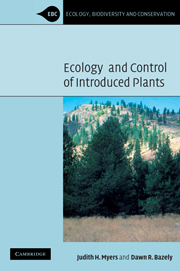Book contents
- Frontmatter
- Contents
- Preface
- 1 Introduction
- 2 Planet of Weeds: exotic plants in the landscape
- 3 Biological invasions in the context of plant communities
- 4 Predicting invasiveness from life history characteristics
- 5 Population ecology and introduced plants
- 6 Introduced plant diseases
- 7 Biological control of introduced plants
- 8 Modeling invasive plants and their control
- 9 Action against non-indigenous species
- 10 Genetically modified plants and final conclusions
- Appendix
- References
- Index
6 - Introduced plant diseases
Published online by Cambridge University Press: 02 December 2009
- Frontmatter
- Contents
- Preface
- 1 Introduction
- 2 Planet of Weeds: exotic plants in the landscape
- 3 Biological invasions in the context of plant communities
- 4 Predicting invasiveness from life history characteristics
- 5 Population ecology and introduced plants
- 6 Introduced plant diseases
- 7 Biological control of introduced plants
- 8 Modeling invasive plants and their control
- 9 Action against non-indigenous species
- 10 Genetically modified plants and final conclusions
- Appendix
- References
- Index
Summary
Introduction
With the introduction of plants and plant products comes associated plant diseases. Diseases are particularly insidious because they may show few or no symptoms on the hosts with which they have evolved. However, native species that are susceptible to these new diseases are likely to have very low resistance or tolerance. Introduced plant diseases have probably had stronger impacts on native plant communities than have their original plant hosts. In some cases, introduced diseases have changed the species composition of forests in a major way.
It is often difficult to identify the origins of plant diseases. A survey of potato, rhododendron, citrus, wheat, Douglas fir and kudzu found that an average of 13% of their pathogens were non-indigenous (Schoulties, cited in OTA 1993). Among forest pests that have been introduced on imported live plants are dogwood anthracnose, Discula destructiva, Melampsora fungus on larch and poplar, and pine pitch canker, Fusarium subglutinans, on Monterey pine. Green wood used in packing and green logs and wood chips are potential carriers for plant disease organisms. Imports of raw wood products from distant sources are increasing and so are the risks of introducing new forest diseases (Campbell 2001). One fascinating case is the introduction of the fungus Cryptococcus neoformans gattii to coastal British Columbia, Canada. This is a saprophyte of tropical eucalyptus trees that has now established on Douglas fir, cedar and alder trees.
- Type
- Chapter
- Information
- Ecology and Control of Introduced Plants , pp. 147 - 163Publisher: Cambridge University PressPrint publication year: 2003

